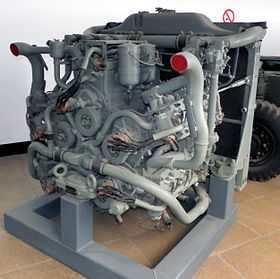Chrysler A57 multibank
| Chrysler A57 Multibank | |
|---|---|
 | |
| Overview | |
| Manufacturer | Chrysler |
| Combustion chamber | |
| Configuration | Multibank |
| Displacement | 1,253 cu in (20.5 L) |
| Cylinder bore | 3.4375 in (87 mm) |
| Piston stroke | 4.5 in (114 mm) |
| Compression ratio | 6.2:1 |
| Combustion | |
| Fuel system | Naturally aspirated (i.e., unsupercharged), Carter TD-1 carburetors[1] |
| Fuel type | Gasoline |
| Output | |
| Power output | 470 hp (350 kW) @ 2400 rpm |
Created in 1941 as America entered World War II, the A57 Multibank engine was born out of the necessity for a rear-mount tank engine to be developed and produced, in the shortest time possible, for use in both the 109 examples built of the M3A4 Medium Tank, and the 7,499 examples built of the successor M4A4 Medium tank, each of which had lengthened hulls to accommodate them.
In order to use existing tooling, five Chrysler 250.6 in3 (4.12 litre; 3.4375" {87.3 mm} bore and 4.50" {114.3 mm} stroke)[1] L-head inline six cylinder engines were arranged around a central shaft, producing a unique 30 cylinder 21 litre (1253 in3)[1] engine in a relatively compact but heavy package. The crankshafts were fitted with gears, which drove a sun gear arrangement.[2] With iron block and head,[1] it featured Carter TD-1 carburetors[1] and 6.2:1 compression ratio,[1] for an output of 470 hp (350 kW) at 2400 rpm.[1] It necessitated a longer hull (same as the M4A6),[3] becoming the M4A4;[3] most of these were supplied to Allied countries under Lend-Lease.[3]
In a February 1944 advertisement on the magazine Popular Science, Chrysler claimed the A57 could still move the tank it was fitted in even if 12 out of its 30 cylinders were knocked out.[4]
The M4A4 was largely supplied to the British, the US preferring the M4A3 with the more conventional Ford GAA V8 engine, and restricting their M4A4s from overseas use.[5]
References
- ↑ 1.0 1.1 1.2 1.3 1.4 1.5 1.6 Berndt, Thomas (1993). Standard Catalog of U.S. Military Vehicles. Krause Publications. p. 193. ISBN 0-87341-223-0.
- ↑ Berndt, p.190.
- ↑ 3.0 3.1 3.2 Berndt, p.192.
- ↑ Popular Science, February 1944, p.7. http://www.google.com/books?id=oiUDAAAAMBAJ&printsec=frontcover&source=gbs_summary_r&cad=0_0#PPP1,M1
- ↑ Fletcher The Universal Tank, p 70
External links
- The Chrysler A57 Multi-Bank Engine - An amazing engine by Julian Edgar of AutoSpeed.